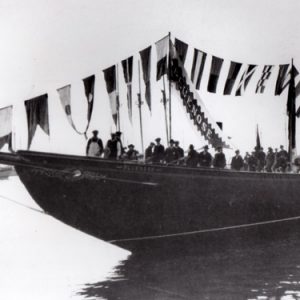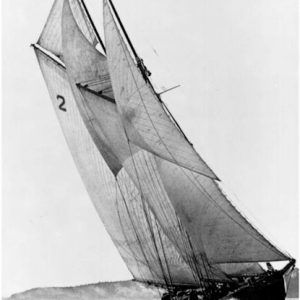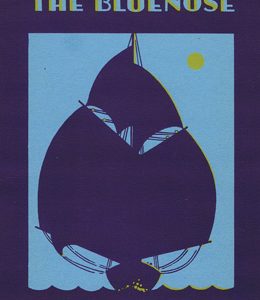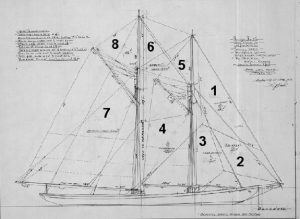Bluenose – The Story
The schooner Bluenose is an internationally famous Canadian historical treasure. She was built in the winter of 1921 by Smith & Rhuland Shipyard in Lunenburg from a design made by W.J. Roué. She was similar in construction to other fishing vessels built in the same yard, although radically different in design.
The materials used in construction were entirely Nova Scotian, except the spars which were made from Douglas fir from British Columbia. The vessel was built to the order of the Bluenose Schooner Co., with shareholders in Lunenburg, Halifax, Montreal, Toronto and other parts of Canada. Captain Angus Walters was made captain, Messrs. Zwicker & Co. of Lunenburg, N.S., agents. The majority of funds for her construction cost of $35,000 were raised through the sale of shares at $100 each.
Her keel was laid on a cold January day with the ceremonial first spike driven by the Governor-General of Canada.
Bluenose was launched with much fanfare March 26, 1921 and sailed for the Grand Banks just over two weeks later after being ballasted, rigged, fitted out and provisioned. She was to be a working vessel, first and foremost, and work she did – earning the title Queen of the North Atlantic fishing fleet for her record catches.
Years later, her one and only master, Captain Angus Walters with whom the Bluenose legacy will be forever linked observed she had paid back every dollar put into her – “and with good interest, too.”
She had not been built solely for fishing but also with the intention she would race, and beat, fishing schooners from New England as they had won the inaugural International Fishermen’s Trophy in 1920 – much to the chagrin of Nova Scotians. Bluenose had a gift for speed and under the steady hand of her one and only master Captain Angus Walters (pictured left) was victorious in trial races with her Canadian challengers, and then against the best American skippers and vessels of the time: the Elsie in 1921, the Henry Ford in 1922, and the Gertrude L. Thebaud in 1931 and 1938.
In 1929 Bluenose was recognized across Canada when a 50-cent stamp was issued in her honour. Captain Walters and William Roué were also honoured with stamps in 1988 and 1998, respectively. Well-known around the world for her racing triumphs Bluenose became a show vessel in the 1930s as the fishing industry was lean. In 1933 she represented Canada at the World Fair in Chicago and on her way home stopped in Toronto where thousands visited her hallowed deck. In 1935 she sailed across the Atlantic to participate in Silver Jubilee celebrations for King George V.
Since 1937 Bluenose has appeared on the obverse of the Canadian 10-cent piece.
In the late ’30s the Second World War saw opportunities for Bluenose almost non-existent. She was no longer paying her way. She had grown old. Hogged, she had lost considerable of her lively speed and could not carry proper ballast for heavy going. She was offered for sale in Lunenburg with no luck. Then to the provincial government – on the premise of the fame she had brought to Nova Scotia; the offer was declined. Bluenose sat moored to a dock in Lunenburg until 1942 when two Americans arrived in the south shore town with a suitcase full of money.
It was Captain Walters alone who had been bearing the cost to keep Bluenose afloat. Since there had been no interest locally to buy Bluenose he felt he had no choice but to sell the ship to the Americans. They paid $20,000 – “a fantastically cheap price, as the name alone was worth God knows what” according to a later account by Jesse Spalding, one of the two Americans.
Later that year Bluenose left Lunenburg for the last time to begin the final chapter of her career, as a freighter. From then on she sailed between Florida and the Caribbean often carrying wartime cargoes of explosives. Her name, it turned out, was worth a lot – as Spalding reports an incident when a German submarine surfaced alongside with its commander hailing Bluenose, saying: “You are the Bluenose…and if I didn’t love that boat I’d shell you right now.”
On the night of January 28, 1946, Bluenose struck a ledge off the coast of Haiti. The next day the engines were salvaged. The following night – after 25 years of work and play – the vessel broke her back and sank.



